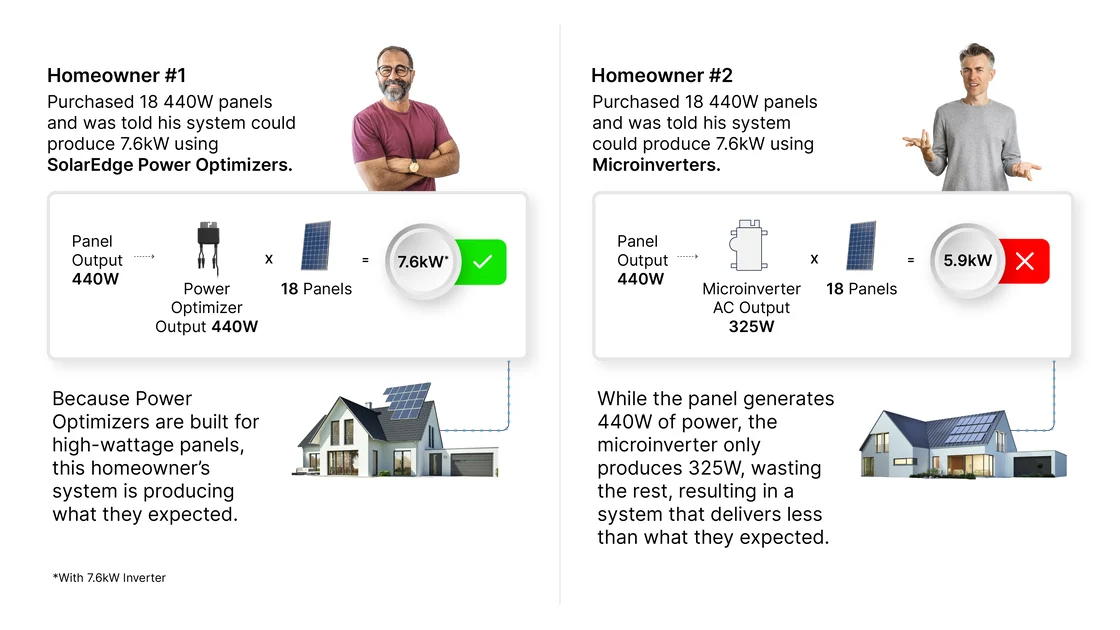We’ve started to hear some solar companies touting how much power their home can generate if they use power optimizers rather than microinverters. For example, see the marketing email from Solar Edge, below:

While on the face of it, Homeowner #1 may seem to be getting a better deal than Homeowner #2. Unfortunately, this messaging conveniently ignores some facts, while highlighting others, obscuring how solar panels and inverters really work!
At Green Mountain Solar, our goal is to provide our customers with as much information as possible to make the right decision for their home.
Below we explain why the comparison above is not quite right. To understand why a home using a 440-watt panel with a 440-watt power optimizer, is not necessarily superior to a 440-watt panel using a 325-watt microinverter, we need to understand how panels are rated and tested, as well as how they are effectively paired with the right inverter.
How Panels are Rated and Tested
Solar panels are tested for their maximum wattage in a laboratory under Standard Testing Conditions (STC). When they’re tested, they’re 77 degrees Fahrenheit with an air mass of 1.5, and 1,000 Watts per square meter of light hitting them. These conditions allow them to reach their maximum output, however it is unlikely these conditions would ever occur outside of the laboratory.
We liken this to the EPA-rated MPG ratings for your car versus real world driving conditions: you wouldn’t expect to hit the EPA-rated MPG rating consistently when driving your car because there are various factors which impact your MPG, like driving habits, road conditions, weather conditions and vehicle maintenance. The same holds true for the maximum power output of solar panels.
When you look at a panel specification sheet, you will see the electrical characteristics of the solar panel under STC and NOCT. NOCT stands for the nominal operating cell temperature. NOCT is the realistic power output of a solar panel in natural conditions.
For example, the Eagle 430-watt panel, which we often install, can produce 430-watts under STC in a laboratory, but realistically can produce up to 323-watts outside in NOCT conditions, as shown in the diagram below.

At Green Mountain Solar, we pair the Eagle 430-watt panel with the Enphase IQ8M micro inverter, which has a peak output rating of 330-watts, making it a perfect pairing!
If we had taken the above diagram at face value, however, homeowners might question if microinverters were the right option for them!
Being Wary of Solar Marketing Tactics
While the simplistic SolarEdge Marketing diagram above makes power optimizers look like a ‘no brainer’, the picture doesn’t show the full story. The crux of the issue is that the rating of the power optimizer at 440-watts, is not what ultimately allows the system to produce more energy.
In the SolarEdge example for Homeowner #1, they have oversized the string inverter, and are assuming laboratory conditions will hold in the real world. They are also assuming power off the roof, is the same as power into the home. However, if real world conditions are at play, this is simply not going to be the case. The industry standard is to instead consider nominal operating cell temperature (NOCT), which better reflects real world operating conditions, which is why option B is likely a superior option.
Conclusion
When choosing the type of solar panels you want for your array, it’s important to do your research on how each one works. Be sure to look at the NOCT rather than the STC for an accurate idea of each panel’s capabilities in realistic conditions.
As we have seen above, we also encourage you to be wary of solar marketing messages that you may read online or get emails about, as they may not tell the whole story. The devil is in the details!
Reach out to us at Green Mountain Solar if you have specific questions for us, or if you’ve read something that doesn’t quite add up. We are here to educate our customers to ensure they make the right decision for their home and energy.


